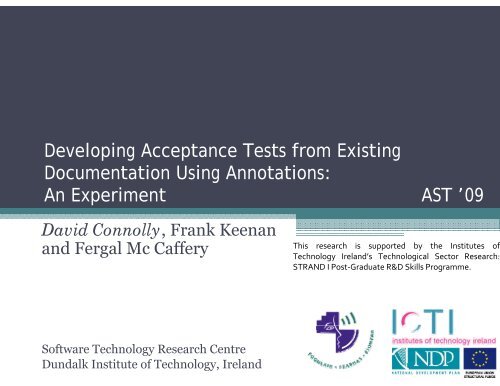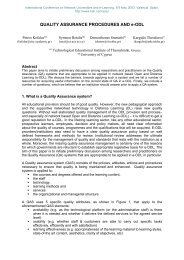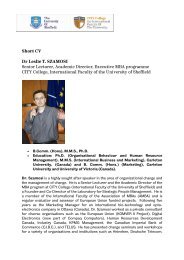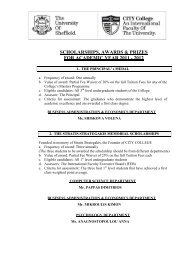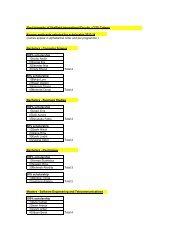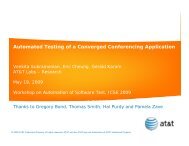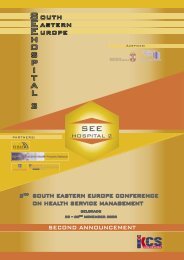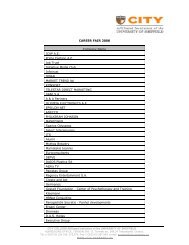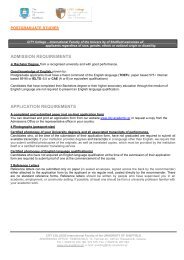David Connolly, Frank Keenan and Fergal Mc Caffery
David Connolly, Frank Keenan and Fergal Mc Caffery
David Connolly, Frank Keenan and Fergal Mc Caffery
You also want an ePaper? Increase the reach of your titles
YUMPU automatically turns print PDFs into web optimized ePapers that Google loves.
1<br />
Developing Acceptance Tests from Existing<br />
Documentation Using Annotations:<br />
An Experiment<br />
AST ’09<br />
<strong>David</strong> <strong>Connolly</strong>, <strong>Frank</strong> <strong>Keenan</strong><br />
<strong>and</strong> <strong>Fergal</strong> <strong>Mc</strong> <strong>Caffery</strong><br />
This research is supported by the Institutes of<br />
Technology Irel<strong>and</strong>’s Technological Sector Research:<br />
STRAND I Post‐Graduate R&D Skills Programme.<br />
Software Technology Research Centre<br />
Dundalk Institute of Technology, Irel<strong>and</strong>
2<br />
Overview<br />
• Introduction:<br />
▫ Agile<br />
▫ Acceptance Test Driven Development (ATDD)<br />
▫ The Framework for Integrated Test (FIT)<br />
•Problem Background<br />
• Research Question<br />
• Experiment Description<br />
• Experiment Results<br />
•Progress to Date<br />
• Concluding Remarks<br />
Introducing<br />
ATDD & FIT<br />
Problem<br />
Background<br />
Research Experiment Progress<br />
to Date<br />
Concluding<br />
Remarks
3<br />
Agile<br />
•Agile Manifesto (K. Beck et. al. / www.agilemanifesto.org)<br />
Individuals <strong>and</strong> interactions over processes <strong>and</strong> tools<br />
Working software over comprehensive documentation<br />
Customer collaboration over contract negotiation<br />
Responding to change over following a plan<br />
•Agile Methodologies<br />
▫ eXtreme Programming (XP)<br />
▫ Scrum<br />
Introducing<br />
ATDD & FIT<br />
Problem<br />
Background<br />
Research Experiment Progress<br />
to Date<br />
Concluding<br />
Remarks
4<br />
eXtreme Programming<br />
•12 inter‐linked practices (K. Beck, 2005)<br />
•Three interact with this project:<br />
▫ Testing<br />
Unit & Acceptance Tests are written before coding<br />
▫ Continuous Integration<br />
System is built regularly with tests executing<br />
automatically.<br />
▫ Whole Team<br />
Customer or Customer Proxy deeply involved with team<br />
Introducing<br />
ATDD & FIT<br />
Problem<br />
Background<br />
Research Experiment Progress<br />
to Date<br />
Concluding<br />
Remarks
5<br />
Acceptance Test Driven Development (ATDD)<br />
•Acceptance Tests are black‐box system tests<br />
•Customer involvement through whole team practice<br />
•ATs are linked to User Stories.<br />
•ATDD extends parts of Unit Testing/TDD increasing<br />
customer focus but not conflicting with testing practice<br />
•Executable, Automated‐ allows Continuous Integration<br />
Variants include:<br />
•Mugridge‐ Story Test Driven Development<br />
•Maurer et.al. Executable Acceptance Driven Development<br />
Introducing<br />
ATDD & FIT<br />
Problem<br />
Background<br />
Research Experiment Progress<br />
to Date<br />
Concluding<br />
Remarks
6<br />
Framework for Integrated Test (FIT)<br />
•A leading open source ATDD Tool in common use on<br />
agile projects with multiple programming languages.<br />
•FIT uses data represented in tables to drive fixture code<br />
which runs against system code.<br />
•Also a Wiki user interface available called FitNesse.<br />
•FitNesse works with traditional non‐web projects.<br />
Introducing<br />
ATDD & FIT<br />
Problem<br />
Background<br />
Research Experiment Progress<br />
to Date<br />
Concluding<br />
Remarks
7<br />
Example FIT Table<br />
WebShop.ValidCard<br />
Card Number Expiry Date Valid?<br />
5500 0000 0000 0004 09 2009 TRUE<br />
4111 1111 1111 1111 09 2009 TRUE<br />
4111 1111 1111 1112 09 2009 FALSE<br />
5500 0000 0000 0004 03 2002 FALSE<br />
Introducing<br />
ATDD & FIT<br />
Problem<br />
Background<br />
Research Experiment Progress<br />
to Date<br />
Concluding<br />
Remarks
8<br />
Problem Background<br />
•Calls for tools which support multiple formats<br />
“textual, tabular, storyboard, graphical, or multimodal”<br />
(J. Andrea, 2007)<br />
• ATDD not well supported by tools from Customers’<br />
point of view.<br />
• FIT Tests are nearly always written by developers from<br />
customer descriptions or documentation.<br />
Introducing<br />
ATDD & FIT<br />
Problem<br />
Background<br />
Research<br />
Question<br />
Experiment<br />
Progress<br />
to Date<br />
Concluding<br />
Remarks
9<br />
Research Question<br />
•To what extent can Acceptance Test Driven Development be<br />
improved by supporting the elicitation of executable<br />
acceptance tests from existing text?<br />
These sub‐questions are related to this question:<br />
• Is current acceptance test authoring process hampered by existing<br />
practices, which often mean the customer is limited to writing<br />
descriptions?<br />
• Is there a loss of fidelity when developers translate customer<br />
descriptions to FIT tables?<br />
Introducing<br />
ATDD & FIT<br />
Problem<br />
Background<br />
Research Experiment Progress<br />
to Date<br />
Concluding<br />
Remarks
10<br />
Experiment: Participants<br />
• Six participants<br />
• Participants:<br />
• R<strong>and</strong>omly assigned to Group A or B<br />
• Worked independently<br />
• Given:<br />
• Four Questions (ATs for a package management system)<br />
• Alternating Annotated & Non‐Annotated<br />
• Task:<br />
• Write FIT Tables from descriptions given in Questions.<br />
Introducing<br />
ATDD & FIT<br />
Problem<br />
Background<br />
Research Experiment Progress<br />
to Date<br />
Concluding<br />
Remarks
11<br />
Experiment: Task<br />
•Group A –Started with non‐annotated version<br />
•Group B –Started with annotated version<br />
Annotated<br />
Non-Annotated<br />
Introducing<br />
ATDD & FIT<br />
Problem<br />
Background<br />
Research Experiment Progress<br />
to Date<br />
Concluding<br />
Remarks
12<br />
Experiment: Annotations in Use<br />
• These annotations are based on elements of an acceptance<br />
test description recommended by N. Jain<br />
Introducing<br />
ATDD & FIT<br />
Problem<br />
Background<br />
Research Experiment Progress<br />
to Date<br />
Concluding<br />
Remarks
13<br />
Experiment: Design<br />
• Metrics:<br />
• Errors<br />
• Correct Elements<br />
• Missing Elements<br />
• Time<br />
• Used to Measure:<br />
• Over‐Specification (Errors)<br />
• Under‐Specification (Missing Elements)<br />
Introducing<br />
ATDD & FIT<br />
Problem<br />
Background<br />
Research Experiment Progress<br />
to Date<br />
Concluding<br />
Remarks
14<br />
Experiment: Results Overview<br />
• In all cases Errors were reduced with Annotations<br />
• On average had more Correct Elements <strong>and</strong><br />
fewer Missing Elements.<br />
•Impact of Time taken need further study<br />
•New type of annotation needed to visualise groupings<br />
Introducing<br />
ATDD & FIT<br />
Problem<br />
Background<br />
Research Experiment Progress<br />
to Date<br />
Concluding<br />
Remarks
15<br />
Progress to Date: Tool Implementation<br />
•Tool implementation in progress:<br />
•Google Web Toolkit for User Interface,<br />
DOM Manipulation <strong>and</strong> RPC/Web Services.<br />
•Previously investigated using ATLAS Transformation<br />
Language to transform between ECore models of<br />
Annotations <strong>and</strong> FIT Tables (also generate fixture code).<br />
•Currently proposing to have new Fixture type work<br />
directly with Annotated document.<br />
Generating FIT tables for discussion only.<br />
Introducing<br />
ATDD & FIT<br />
Problem<br />
Background<br />
Research Experiment Progress<br />
to Date<br />
Concluding<br />
Remarks
16<br />
Progress to Date: Other<br />
•Investigation into authoring of User Stories from<br />
existing documentation. Poster, appeared at ECBS ’08<br />
(Belfast, Northern Irel<strong>and</strong>)<br />
•Initial outline of prototype tool. Appeared at Research in<br />
Progress session of Agile ’08 (Toronto, Canada)<br />
•Initial outline of a modeled approach to translating from<br />
annotations to fixture code & FIT Tables. Appeared at<br />
Doctoral Symposium of EuroSPI 2 (Dublin, Irel<strong>and</strong>).<br />
Introducing<br />
ATDD & FIT<br />
Problem<br />
Background<br />
Research<br />
Proposed<br />
Solution<br />
Progress<br />
to Date<br />
Concluding<br />
Remarks
17<br />
Concluding Remarks<br />
•Tool implementation <strong>and</strong> planning of experiments<br />
continuing this summer.<br />
Release 1<br />
•Further experiments continuing into early 2010<br />
With larger groups including undergraduates<br />
•Planning a Case Study involving prototype with a<br />
company/team adopting ATDD & FIT.<br />
Introducing<br />
ATDD & FIT<br />
Problem<br />
Background<br />
Research<br />
Proposed<br />
Solution<br />
Progress<br />
to Date<br />
Concluding<br />
Remarks
18<br />
Thanks for Listening!<br />
•Questions?<br />
•For more information please contact:<br />
<strong>David</strong> <strong>Connolly</strong><br />
▫david.connolly@dkit.ie<br />
Supervisors:<br />
<strong>Frank</strong> <strong>Keenan</strong><br />
▫frank.keenan@dkit.ie<br />
<strong>Fergal</strong> <strong>Mc</strong> <strong>Caffery</strong><br />
▫fergal.mccaffery@dkit.ie<br />
This research is supported by the Institutes of<br />
Technology Irel<strong>and</strong>’s Technological Sector Research:<br />
STRAND I Post‐Graduate R&D Skills Programme.


